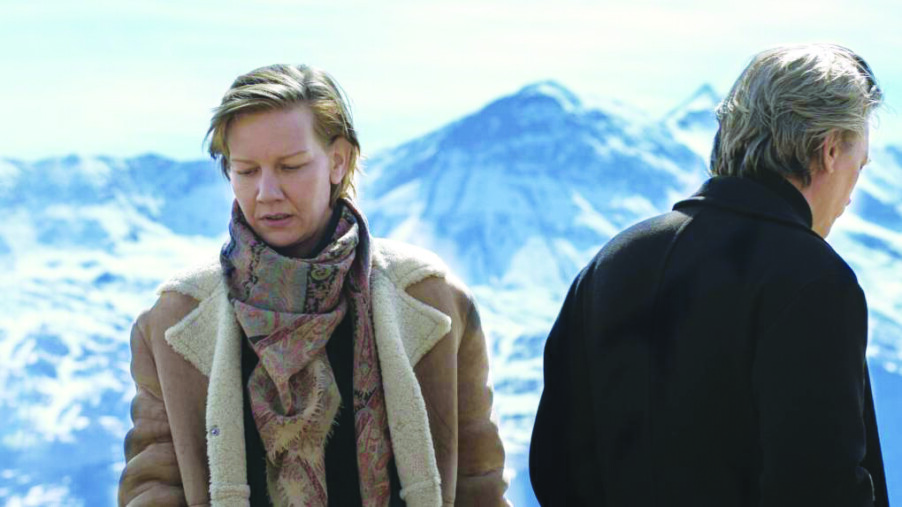A man dies after a fall at his home and his wife becomes the prime suspect for his murder in Anatomy of a Fall.
“Fall” and “murder” are two potentially inaccurate words in that sentence. When Daniel (Milo Machado Graner), a boy with limited vision, comes home from a walk with his guide dog, all he knows is that his father, Samuel (Samuel Theis), is on the ground, bleeding and not breathing in front of the family’s home, a chalet in a small French town. Daniel calls for his mother, Sandra (Sandra Hüller), who frantically calls an ambulance.
Sandra is pretty sure Samuel fell from the attic he was renovating some three stories off the ground. As she is telling this theory to defense attorney Vincent Renzi (Swann Arlaud), clearly this story is not one the authorities are buying. Vincent suggests they pursue the idea that Samuel jumped to his death — the most believable possible alternative to the police and prosecuting attorney’s theory that Sandra pushed him. As Sandra stands trial, the story quickly becomes the anatomy of a marriage, with both sides pointing to “evidence” that feels subjective at best. The prosecutor’s expert says a blood splatter could only have been caused by Samuel being struck in the head before he fell; the defense’s expert says the splatter is clearly the result of Samuel having hit a small shed after he jumped. A recording that features Samuel and Sandra fighting about the state of their lives is either evidence of successful author Sandra’s controlling nature (they even speak English at home because Sandra, a native German, is still not super comfortable in French) and general dishonesty (she’s had affairs and blames Samuel for the accident that caused Daniel’s vision impairment) or it’s evidence of Samuel’s professional disappointment and inability to finish anything he starts. Even Daniel is dragged onto the stand, to talk about the day Samuel died and the general state of his parents’ marriage. The prosecutor (Antoine Reinartz) goes at him pretty hard despite his young age, getting him to weigh in about the likelihood that his father would try to end his life or that his mother would try to kill him.
Jack McCoy would never.
Admittedly, most of what I know about sensationalistic American trials comes from TV, largely from Law and Order, so who knows if the “Real Housewives reunion” vibe of the French criminal court pictured here has any connection to reality. Though we spend much of the movie’s runtime in court, I don’t think the legal case is the point so much as the perspectives on a relationship that even the two people in the relationship never truly get a full picture of. Samuel paints himself as a selfless martyr but also acts a bit like a sullen jerk. Sandra blames Samuel for a lot of his own misfortune but she doesn’t exactly seem like a fountain of empathy for her spouse. The movie does a good job of showing how, even in cases where people are being completely honest (and we get the sense that these two are never completely honest, not with each other or themselves), they can tell two completely different stories about what’s happening between them with both stories being basically true. Hüller gives a good performance as a woman who is sort of sliding down a muddy slope of trying to prove something as unquantifiable as her intentions while also trying not to lose her confused, devastated child. Even if there are moments when you feel like some of the movie’s nuance is being lost in language and cultural translation, the commentary on the complex nature of a marriage comes through clearly. B+
Rated R for some language, sexual references and violent images, according to the MPA on filmratings.com. Directed by Justine Triet and written by Justine Triet and Arthur Harari, Anatomy of a Fall, which won Golden Globes for Best Screenplay and Best Foreign Language Film, is two hours and 32 minutes long and distributed by Neon. It is available for rent or purchase.
Saltburn (R)
A poor boy at Oxford befriends the son of a wealthy family with a giant estate in Saltburn, a comedy.
Like, a trashy, pitch black comedy full of purposeful shocks and pushing the limits of an R rating but still, this bawdy, violent song bellowed through the halls of Downton Abbey definitely feels like a comedy.
Dickensianly named Oliver Quick (Barry Keoghan) must give off the pheromones of “poor” because the kids at Oxford seem to instantly know to shun and make fun of him, especially Farleigh Start (Archie Madekwe), who we later learn is himself poor but a different kind of poor. Farleigh’s mother is the sister of the very wealthy Sir James Catton (Richard E. Grant), who pays for Farleigh’s education. So Farleigh is money-adjacent — all of which we learn from golden boy Felix Catton (Jacob Elordi), James’ son and Farleigh’s cousin. Felix and Farleigh are studying at Oxford together — well, studying and partying. Oliver, with his sad clothes and his general slouchiness, is very much on the outside looking in at all of this but then, due to a busted bicycle tire, Oliver befriends Felix. Felix sort of takes him under his wing, and brings him along into the popular crowd. We learn that Felix has a tendency to do this sort of thing, eventually dropping the kid for a new person to serve as adoring audience. Before that happens with Oliver, though, Oliver turns to Felix to tearfully recount the news he has received about the death of his father, who, like Oliver’s mother, has long struggled with drugs. Felix feels sorry for Oliver and the poor, poor, poverty-filled impoverished background Oliver has mournfully told him all about. Felix invites Oliver to spend the summer in Saltburn, the family’s large estate in the country.
There Oliver quickly becomes enmeshed in the Catton family, which also includes Felix’s mother Elspeth (Rosamund Pike), Felix’s bundle-of-neuroses sister Venetia (Alison Oliver) and Elspeth’s visiting friend Pamela (Carey Mulligan) — whose presence suggests that Elspeth also likes to collect poor poor friends. The family, who are the personification of that The Great Gatsby quote that was all over the internet in late 2020 and early 2021 about people who retreated into “their money or their vast carelessness,” seems to more or less take a shine to Oliver. Farleigh, who is also at Saltburn for the summer, and the butler Duncan (Paul Rhys) are actively hostile to Oliver. Dressing for dinner and lounging louchely by the pool and just generally cosplaying Evelyn Waugh, the group gets along mostly until Felix makes a, gasp, shocking discovery.
Well, gasp shocking if you’ve never seen a soap opera before or weren’t really paying attention to the first half of this movie.
The bits of not-great reviews I heard about Saltburn had me dragging my feet to watch it until I heard Joe Reid on his This Had Oscar Buzz podcast paint it as, like, think of it as a Cruel Intentions type movie. So maybe I went in perfectly primed to not expect much and ready to enjoy some oversexed trashiness. My suggestion would be to approach this movie that way and you won’t be disappointed — grossed out maybe but not disappointed because this movie really leans into its trashiness. Saltburn is vaguely Brideshead Revisited-ish, says me, a person who doesn’t really remember Brideshead Revisited (and the movie knows the stuff it’s playing with, based on an in-film reference to Waugh and also the song “Common People”), in its outward trappings. But its heart is pure soap opera camp and mean humor.
And to this it adds solid performances. Pike and Grant are excellent at giving us the askew version of the empty-headed rich; they are so at an angle that I feel like their presence alone gives away the game if you think the movie is handing you a straightforward English manor drama. Keoghan is also doing perfectly calibrated work — serving up a never-not-(meanly)-funny blend of sad puppy and psychopath.
Saltburn might appear to be an exquisitely plated beef Wellington but is a good time if you enjoy it for the cheese-filled hot dog it really is. B
Rated R for so, so many things, like really, this is a capital R rated R movie but specifically, according to the MPA on filmratings.com, with my notes: for strong sexual content (also, weird sexual content), graphic (but hilarious?) nudity, language throughout, some disturbing violent content (also puking) and drug use. Written and directed by Emerald Fennell, who probably had a great time with this whole thing, Saltburn is two hours and 11 minutes long and is distributed by Amazon Studios. It is streaming on Prime Video.
Society of the Snow (R)
A flight carrying 45 people, including a Uruguayan rugby team, crashes in the Andes in 1972, with a dwindling number of people surviving for months, in Society of the Snow, which is, yes, based on the same true story as the 1993 movie Alive.
The one fact about this historical event that you probably know, even if you didn’t know “Uruguay” or “rugby” or “1972,” is that eventually the survivors had to eat the bodies of their deceased friends and teammates in order to stay alive in the snowy but otherwise barren environment (so, plenty of water but nothing else). Actually, “eventually” happens pretty quickly, at least as portrayed here, where after maybe a week or so of no food (there was a small amount of snacks from the plane) many of the survivors made the calculation that this would be the only way they’d live until a rescue. Not all of the survivors, mostly rugby teammates and a few people who traveled with them hoping to get a cheap vacation in Santiago, Chile, agree with the plan to use the, ahem, available protein to keep up their strength. But eventually, on a radio they’re able to get working, they hear that the search for the missing plane has been called off due to weather. With the prospect of no immediate rescue, it seems pretty much everybody makes the choice to survive.
Survival, not cannibalism, is the focus of this movie, which doesn’t sensationalize the fact but puts it in the context of what is happening with the group and the struggle each person goes through to get over the taboo. One thing that seems to make a difference is when everybody offers their friends to “use” them if they die. And quite a few do die after the initial crash — from injuries suffered during the crash, from infections following injuries, from an avalanche. How they keep themselves and each other going in the face of these losses and relatively slim odds that they’ll make it back home is the story that keeps the movie going.
The movie does a good job of making this group of mostly men feel like real people stuck in a horrible situation. Some heroes go the extra mile, some people nearly break from the direness of what’s happening — sometimes these are the same people at different times. The movie gives a fairly engrossing and realistic portrait of young men (mostly) who have to figure out how to save themselves. B
Rated R for violent/disturbing material and brief graphic nudity, according to the MPA on filmratings. Com. Directed by J.A. Bayona with a screenplay by J.A. Bayona and Bernat Vilaplana & Jaime Marques-Olarreaga & Nicolás Casariego, Society of the Snow is two hours and 24 minutes long and streaming on Netflix.
Featured photo: Migration.






